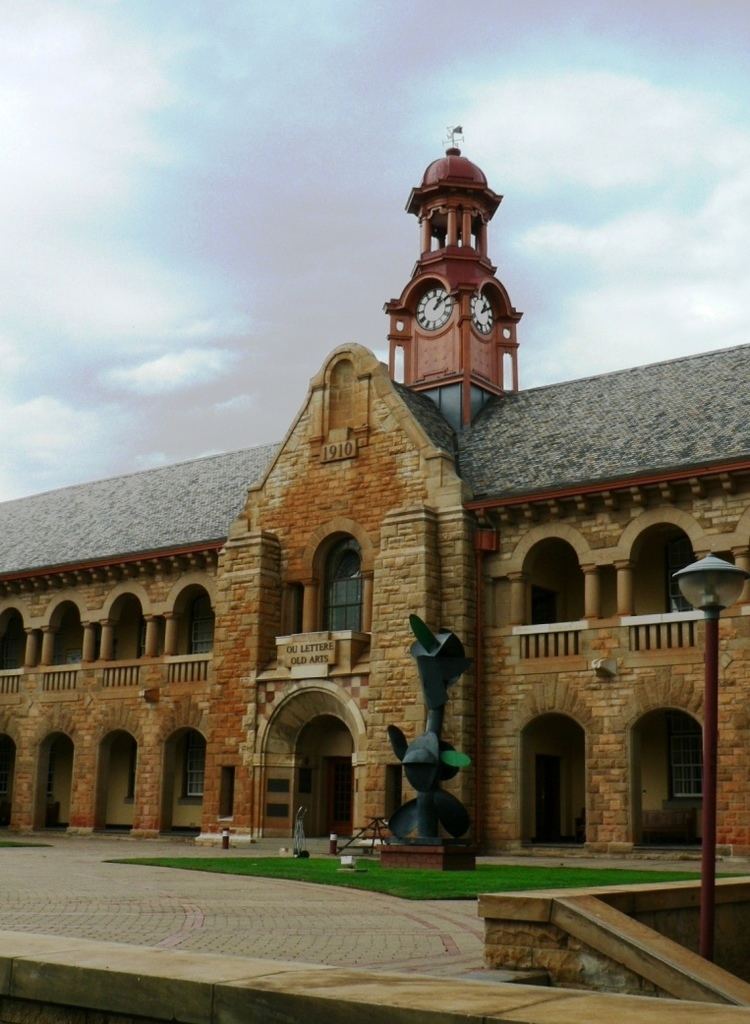Mascot Oom Gert Dean Sunil Maharaj | Established 1908 Founded 1908 Colors Red, Blue, Gold | |
 | ||
Former name Transvaal University College (1908–1930) | ||
The University of Pretoria Faculty of Engineering, the Built Environment and Information Technology (commonly referred to as EBIT) educational programs stretch back to 1908 and consists of the School of Engineering, School for the Built Environment, School of Information Technology and the Graduate School of Technology Management. The university is the only African collaborator in the CDIO engineering initiative: Since 1997, the university as a whole has produced more research outputs every year than any other institution of higher learning in South Africa, as measured by the Department of Education's accreditation benchmark.
Contents
History
The proposal for a university for the capital, first mooted in the Volksraad in 1889, was interrupted by the outbreak of the Anglo Boer War in 1899. In 1902 after the signing of the Peace of Vereeniging, the Normal College for teacher training was established in Groenkloof, Pretoria and in 1904 the Transvaal Technical Institute, with emphasis on mining education, opened in Johannesburg. In 1906 the Transvaal Technical Institute changed its name to the Transvaal University College. On 4 March 1908 when the Transvaal University College (TUC) transferred its arts and science courses to its newly established Pretoria Campus the precursor to the university was established, initially offering courses in languages, sciences, and law. The Department of Architecture was officially established 1943.
Academics
The School of Engineering offers the undergraduate and postgraduate programmes in chemical engineering, civil and biosystems engineering, electrical, electronic and computer engineering, industrial and systems engineering, materials science and metallurgical engineering, mechanical and aeronautical engineering, mining engineering and the postgraduate only engineering and technology management programmes.
The School for the Built Environment offers the undergraduate and postgraduate programmes in architecture, landscape architecture, interior Architecture, quantity surveying, construction management, and town and regional Planning.
The School of Information Technology offers the undergraduate and postgraduate programmes in the fields of computer science, informatics and information science.
The Graduate School of Technology Management offers the postgraduate programmes in the fields of technology, management, project management, engineering management, life cycle managementand asset management.
Accreditation and affiliations
Engineering programmes are accredited by the Engineering Council of South Africa (ECSA) and recognised internationally through the Washington Accord in Australia, Canada, Chinese Taipei, Hong Kong, China, Ireland, Japan, Korea, Malaysia, New Zealand, Singapore, Turkey, the United Kingdom and the United States of America.
The CDIO Initiative (CDIO is an initialism for Conceive — Design — Implement — Operate) is an innovative educational framework for producing the next generation of engineers. The framework provides students with an education stressing engineering fundamentals set in the context of Conceiving — Designing — Implementing — Operating real-world systems and products. Throughout the world, CDIO Initiative collaborators have adopted CDIO as the framework of their curricular planning and outcome-based assessment.
CDIO was formally founded by Massachusetts Institute of Technology in the late 1990s. In 2000 it became an international collaboration, with universities around the world adopting the same framework. The collaborators maintain a dialogue about what works and what doesn't and continue to refine the project. Determining additional members of the collaboration is a selective process managed a Council comprising original members and early adopters.
Student activities and community engagement
Reputation and ranking
The QS World University Rankings ranks the faculty as follows:
Recent awards won by architecture students include:
Alumni
Well known alumni include: Marius Kloppers is the international CEO of BHP Billiton, the world's largest mining company and named by CNN Money as the world's 18th most powerful person in business. Calie Pistorius is a South African academic who is currently the Vice-Chancellor of the University of Hull, United Kingdom.
